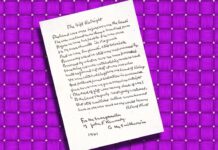We live in a world of technology backed communication. E-mails, texts, etc are most of our preferred modes of communication. However, letters still have a major use and importance in our society, especially formal letters written to authorities or professional contacts, because they generally stay on record.
A formal letter is one written in a formal and conventional language and follows a certain stipulated format. These letters are written for official purposes only, such as writing a letter to the manager, to the HR manager, to an employee, to the Principal of the college or school, to a teacher, etc. A number of conventions must be adhered to while drafting formal letters.
Formal letter writing format requires some specific rules and conventions. The language of the letters should be very professional. Furthermore, try to write as simply and as clearly as possible, and not to make the letter longer than necessary. Remember not to use informal language like contractions. An example of a formal letter is writing a resignation letter to the manager of the company, stating the reason for resignation in the same letter.
There could be many reasons to write a formal letter.
- Sick leave application
- Leave application for marriage
- Leave application for maternity
- Resignation letter
- Appointment letter
- Job offer letter
- Complaint letter
- Business letter
To write a formal letter follow the below-given tips.
- Address or greet the concerned person properly like Dear Sir/Madam.
- Always mention the subject of writing the letter.
- Be concise in your letter. Write the reason for writing the letter in the first paragraph itself.
- Do not stretch the letter too much.
- The tone of the letter should be very polite and not harsh.
- Write in a proper format and take care of the presentation of a letter.
- Mention the address and date correctly.
- Mention the name and designation of the recipient correctly
- The closing of the letter should be with gratitude. Use “Thank you” for consideration of the letter and then at last mention “Yours sincerely or truly” along with your name and signature.
In today’s Internet- and email-driven society, the need to write a formal letter arises less often than in the past. However, it is still occasionally necessary to present a formal letter to obtain information, to apply for an academic program or a job, to write a complaint letter, or simply to express your opinion in an effective and coherent manner.
Be Concise
State the purpose of your formal letter in the first paragraph and don’t veer from the subject. Try to avoid flowery language or long words. Keep the letter short and to the point. Vigorous writing is concise. A sentence should contain no unnecessary words, a paragraph no unnecessary sentences, for the same reason that a drawing should have no unnecessary lines and a machine no unnecessary parts. This requires not that the writer make all sentences short, or avoid all detail and treat subjects only in outline, but that every word tell.
Use the Right Tone
A business or formal letter should be written in a tone that is slightly more formal than your everyday language. Avoid the following: slang or jargon; contractions such as I’m, can’t, it’s, and vague words such as good and nice. Be polite and respectful, even if you are complaining.
Proofread
Proofreading is so important. Once you have written your formal letter, check the grammar and spelling carefully. Use the spellchecker on your computer and then read the letter over yourself as the spellchecker will not catch every error. Use a dictionary or thesaurus, if necessary. Check the grammar and punctuation for correctness and make sure the sentences are complete.
It is a good idea to have someone else proofread your formal letter, even after you have done so, as you may have overlooked errors in something that you have read over many times. If this formal letter is important enough for you to take the time to write, don’t rush its completion. Errors will diminish the impact of the statement or impression you are trying to make.
Use Proper Format and Presentation
Remember that the first impression is the one that lasts. Use good quality paper and a matching envelope for your formal letter. Make sure the recipient is addressed properly and that his or her name is spelt correctly. Equally important—don’t forget to sign the letter!
Present Your Ideas Properly
Adhering to the standard conventions of good formal letter writing and presenting your letter attractively will ensure that your thoughts are seriously considered by the recipient and given the attention and consideration they deserve.
Heading
The heading consists of your address (but not your name) and the date. Telephone numbers and email addresses are not usually included here, but they are acceptable. Using block format, the heading goes in the top left-hand corner of the page.
Inside Address
The inside address consists of the name and address of the person to whom you are writing. Try to address the formal letter to a specific person, but if you do not know his or her name, at least try to include his or her title. This address is usually placed four lines below the heading if a word processor is used or one line below the heading if the letter is handwritten.
Salutation or Greeting
1) Dear Sir or Madam,
If you do not know the name of the person you are writing to, use this. It is always advisable to try to find out a name.
2) Dear Mr Jenkins,
If you know the name, use the title (Mr, Mrs, Miss or Ms, Dr, etc.) and the surname only. If you are writing to a woman and do not know if she uses Mrs or Miss, you can use Ms, which is for married and single women.
Body
Skip one line after the salutation and begin typing the body of the formal letter. This is the main part of the letter. Keep in mind the rules outlined above regarding brevity and coherence. It is best to use short, clear, logical paragraphs to state your business.
Closing and Signature
This is the end of the letter. Skip one line after the last paragraph of the body of the letter and type the closing. Only the first word of the closing should be capitalized. It is punctuated with a comma. Leave several lines after the closing and type (or print) your signature. Your actual handwritten signature is to be inserted between these two printed lines, written in ink.
Your typed signature marks the end of your letter, and while you can write a postscript (P.S.) containing additional information, it is better to include all pertinent details in the body of the letter itself so nothing is accidentally overlooked.
Now that your formal letter has been written, read it through in its entirety to ensure you have communicated your points thoroughly and accurately. Then, it’s ready to be sent off to its recipient!



























